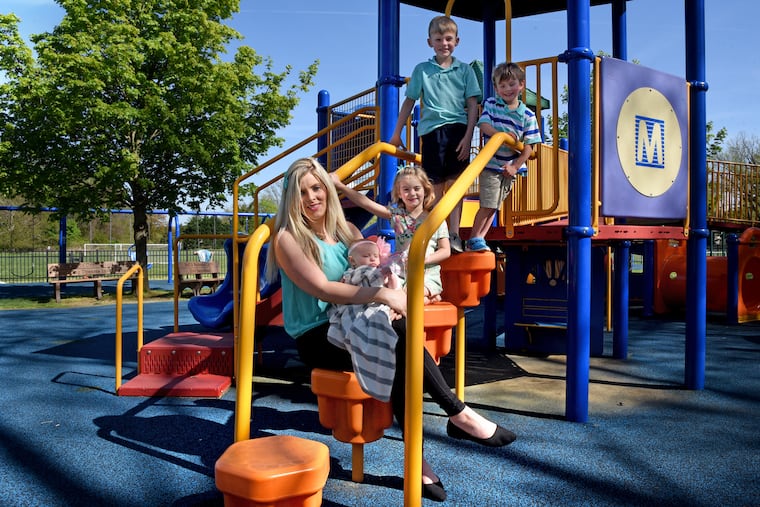Pivoting to middle school teacher from bank teller to stay ahead of disruption
Bank teller Jaclyn Mazuk didn't like her prospects in banking amid the growing trend toward digital transactions. So she pivoted to middle school teaching.

As the COVID-19 crisis deepened, bank teller Jaclyn Mazuk didn’t need an economics degree to forecast the future of branch banking.
Early on the pandemic, when her branch became drive-in only, she saw it as the acceleration of a trend already in motion — from automatic teller machines decades ago to the digital and mobile banking service so prevalent now. “While the pandemic has acted as a catalyst and accelerator, the digitization of banking had already reached a tipping point at large banks,” said a January report by Deloitte, the accounting firm.
“The pandemic made it scary,” said Mazuk, a 31-year-old mother of four children. “Banks are not going to go away, but I think they are going to start closing branches.”
So, she made a pivot. For Mazuk, the future of work was teaching middle school.
“Education isn’t going anywhere. Everyone needs to learn,” she said. “It’s a state-mandated thing that kids go to school, but it’s not state mandated to go to the bank.”
Mazuk, of Ridley Township, who had an associate’s degree from a community college and is now a full-time student at West Chester University, is just two semesters away from earning her bachelor’s degree in education with a certification in middle school teaching; both are required to teach in Pennsylvania. She will earn a bachelor’s degree and a Level 1 one certificate, which allows her to teach for six years. After that she will have to take more courses to get a Level 2 certificate.
Mazuk likes helping children learn and certainly appreciates the upgrade in pay.
The U.S. Bureau of Labor Statistics reports that the average pay for middle school teachers in the region is about $72,000, although starting salaries are considerably lower. As a bank teller, she made $18 an hour, or about $37,000 a year. If she lands a job as a middle school teacher in her home district, she’ll start at $41,000; statewide, the average starting pay is $44,000.
Mazuk said she gravitated to middle school students — typically aged 11 to 13 — after observing a second-grade classroom. “I thought it was overwhelming for one person. I think I like the older guys. If they have an attitude, I can handle it.”
What is the future of work for teachers?
“Every few years we hear how technology is going to disrupt education,” said Pam Grossman, dean of the graduate school of education at the University of Pennsylvania. It hasn’t happened yet, she added.
As a relatively recent example, she pointed to the hand-wringing that accompanied the emergence of massive or multiple open online courses, also known as MOOCs, in 2008. College administrators worried that these stay-at-home courses would replace on-campus enrollment.
The courses, ranging from Yale’s popular Science of Well-Being with its 3.5 million students enrolled, to Duke University’s Oil and Gas Industry Operations and Markets with 92,000 students, have found their niches. But Grossman said they have not really disturbed the value proposition offered by teachers.
The importance of the teacher relationship is the same at all levels, Grossman said, from college to kindergarten. “Teaching and learning are fundamentally relational processes, and without the relationship, it’s hard to engage learners, particularly those that aren’t motivated,” Grossman said. She cited a California experiment in which a college enrolled one group in a MOOC course and the other in a teacher-led course.
The MOOC group did worse, “in part because of the human element. There was no one to help them get oriented,” she said. “You need to build the relationship that helps them persevere.”
Even so, she said, technology will impact teaching. “I think technology will augment learning in new and exciting ways,” she said, requiring an “even more skilled teaching force that knows how to leverage it.”
Online instruction during the pandemic forced teachers to become more familiar with technology as a teaching tool. They learned to use computerized white boards, videos, break-out rooms, online mini polls and classroom delivery systems such as Google Classroom. Professional development seminars in the field now stress the importance of blending technology and in-person instruction.
Whether there will be a teacher shortage is debatable, but there are some worrisome signs. In the 2010-2011 school year, 12,297 people earned education degrees in Pennsylvania. By 2018-2019, that number dropped to 5,720. Nationally, enrollment in teacher preparation programs declined by a third in that same period, according to federal reports.
The U.S. Labor Department projects that middle school teaching jobs, along with all school-age teaching positions, will grow about 4% by 2029 — about the same projected rate for all occupations. Across the United States, 627,100 middle school teachers handle the angst and education of preteens in sixth, seventh and eighth grades, according to the U.S. Labor Department’s most recent statistics, dated 2019.
More than 22,500, including Mazuk, will join their ranks by 2029, the Labor Department projects.
By contrast, employment as a bank teller is expected to decline by 68,600 jobs, or 15%, over the same time period.
Part of Mazuk’s pre-pandemic responsibilities at her bank branch included teaching customers how to use mobile banking apps. She remembers the day a customer asked her, “`Why are you doing this? You guys aren’t going to have jobs.’”
Point taken. Pivot made.
Know anyone pivoting to a new line of work? We’d like to profile people who have looked at the future of their current occupations and decided to make a move. Contact janevonbtheater@gmail.com or eminaya@inquirer.com
The Future of Work is produced with support from the William Penn Foundation and the Lenfest Institute for Journalism. Editorial content is created independently of the project’s donors.